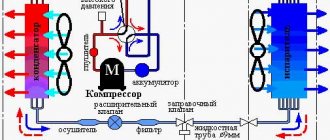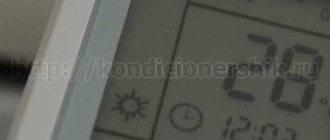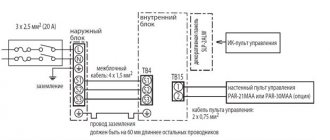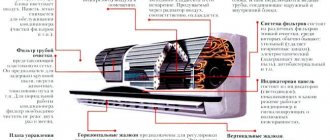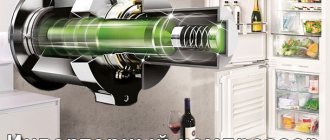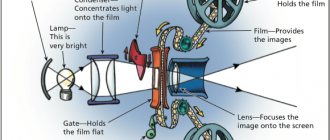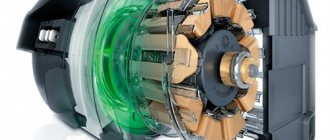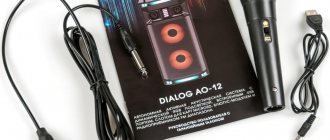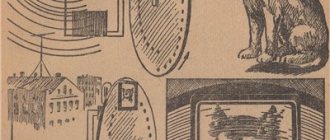How does a regular air conditioner work?
Conventional air conditioners are called start/stop or on/off systems. In them, the compressor periodically turns on and off. Operating cycle of a non-inverter air conditioner:
- The compressor turns on, freon circulates through the system and cools (heats) the room.
- When the temperature reaches the set temperature, the compressor turns off. The refrigerant stops circulating through the system.
- The indoor fan continues to circulate air to ensure mixing and even temperature distribution.
- When the refrigerant or room air temperature changes by 1-2 degrees, the compressor turns on again.
If the air conditioner is of normal quality, you will not notice that the compressor turns on or off. This can be determined when you are under a stream of air at the moment you turn it on. Depending on the mode (heat or cold), the air from the indoor unit will slightly change the temperature.
Selecting the best models
The choice in HVAC stores today is so wide that it is difficult for the average buyer to make the right choice. It is necessary to take into account not only the manufacturer of the equipment and the specific model, but also power indicators, installation method, possibilities for subsequent expansion of functionality and a number of other characteristics. By choosing the right air conditioner, you can subsequently completely solve problems with heat and cold in the room, while such equipment will not cause any trouble during operation.
Air conditioning systems from Daikin
The Japanese company Daikin is one of the world leaders in the production of climate control equipment. The offer includes two product lines: FTXN and FTX. Such air conditioners differ in their purpose, power and installation method. The ratings of inverter air conditioners are invariably topped by models from this Japanese brand. You can choose both compact wall-mounted options and powerful equipment that is best mounted on the floor.
Both presented lines of Daikin climate control equipment are distinguished by a long service life , have excellent ergonomics and good energy-economic indicators, are characterized by minimal noise, and a large assortment will allow each buyer to choose the optimal model that fully suits his requirements. The only drawback is the high cost, which is typical for products of all Japanese brands.
Inexpensive devices from LG
Air conditioners built using inverter technology from the South Korean manufacturer LG are very popular. In the offer of this brand you can find universal equipment intended both for domestic use and for installation in offices and large administrative buildings. Installing an inverter air conditioner from this manufacturer is not particularly difficult.
We recommend that you read: The benefits and harms of air ionizers for an apartment
The advantages of LG air conditioners include:
- minimal wear rates;
- high power;
- availability of fully automatic control;
- minimal noise;
- excellent efficiency and economy;
- available range of choice;
- affordable prices;
- long-term quality guarantee.
Buyers are offered both relatively simple and inexpensive models that do an excellent job of cooling an apartment with an area of 50-60 square meters, as well as fully automated kits that feature advanced functionality and are capable of maintaining an optimal indoor microclimate in a completely autonomous mode. An undoubted advantage of air conditioners is the presence of numerous LG service centers, which greatly simplifies the maintenance and repair of such equipment.
Electrolux and Beko
The main advantage of such air conditioners is their reliability, functionality and affordable cost. If models from Japanese brands with similar functionality and power can have a price of 100-150 thousand rubles, then equipment from Beko and Electrolux is offered much cheaper, so every buyer can afford it.
Beko inverter split systems are popular on the market, combining attractive appearance, ease of installation and high power. Some models have a built-in air ionizer and are equipped with a dehumidification function. Buyers can choose installations for a specific area of the premises, and the brand’s offer includes models for both apartments and installations for use in administrative buildings, shopping malls and office buildings.
Electrolux is a leading Swedish manufacturer of household appliances. The brand’s inverter splits have proven themselves to be high-quality and versatile appliances. They are equipped with simple controls, the automation is reliable and durable and is fully optimized for use in cold climates. Split systems have anti-icing protection, so they can be used all year round to cool and heat indoor air.
Cassette inverter air conditioners are in demand among buyers today, due to the functionality, versatility and cost-effectiveness of the equipment. You just need to decide what an inverter air conditioner means and its differences from standard models. By choosing an inverter or conventional air conditioner from leading brands, you can be sure of the versatility of use.
On sale you can find equipment models from European brands, as well as fully automated, powerful, ultra-modern Japanese installations. You need to decide on the subsequent use of the equipment, which will allow you to purchase a high-quality air conditioner, which during operation will not cause any hassle or difficulties.
How does an inverter air conditioner work?
In an inverter air conditioner, the compressor does not turn off. It works constantly, but at different speeds. Electricity consumption and performance change accordingly. Inverter air conditioner operating cycle:
- The compressor turns on, the refrigerant circulates through the freon line, and the air in the room is heated or cooled.
- When the temperature reaches the temperature you set, the compressor slows down.
- As soon as the air warms up or cools by 0.5-1 degrees, the compressor picks up speed.
- When the room cools down to the desired level, the speed drops.
When an inverter air conditioner is operating, like a conventional air conditioner, the fan of the indoor unit is constantly running. It is responsible for mixing and distributing air throughout the room. In rooms served by inverter split systems, the temperature difference rarely exceeds 0.5 degrees.
Description of equipment
First of all, you need to decide what an inverter air conditioner means. A distinctive feature of the devices is their power part, which allows you to increase and decrease the frequency of the electric current, while ensuring stable operation of the equipment.
Automatic control monitors all parameters, simultaneously ensuring a reduction in energy consumption for heating and cooling the room.
When turned on, such an inverter air conditioner immediately operates at maximum, and as soon as the temperature in the room is lowered to the values specified by the user, the power of the equipment drops to a minimum, while the equipment does not turn off completely. This operating principle distinguishes inverter climate control equipment from standard split systems and air conditioners.
The design of the inverter air conditioner consists of the following elements:
- inverter;
- power unit;
- generator;
- Control block;
- numerous remote sensors;
- compressor.
Today on sale you can choose various modifications of air conditioners that differ in power ratings. These can be small installations, which will be an excellent option for owners of small apartments. You can also choose powerful, versatile equipment that can cope with cooling and heating air in a room with an area of 300-500 square meters or more.
Modern installations are fully controlled by automation, which receives data from numerous external sensors, and at their command, the intensity of the equipment’s operation increases or decreases. In comparison with classic split systems, only due to the presence of an inverter and control automation, energy savings of 20-30% are achieved. This technique is efficient in use, allowing you to heat or cool a large room in the shortest possible time.
Why is an inverter more expensive?
No matter how stupid it sounds, an inverter air conditioner has an additional component - a voltage inverter. It is responsible for the speed of the compressor. The more filling there is in a technique, the more expensive it costs.
The operation of a voltage inverter is based on switching a constant voltage source to periodically change the polarity of the voltage at the load terminals. The switching frequency is set by control signals generated by the control circuit (controller).
Article about Voltage Inverters on Wikipedia
The main difference in the structure of conventional non-inverter models from inverter ones is the presence of a voltage inverter. Without it, it is impossible to regulate the operation of the compressor. In simple words, the principle of operation can be explained as follows:
In conventional split systems, the signal from the temperature sensor is processed by the air conditioner control board. It gives a signal when to turn on or turn off the compressor.
In inverter models, the control board responds to the temperature sensor readings. It calculates at what speed the compressor should operate and what voltage is needed for this. The board gives a command to the inverter, which converts standard 220V into the required voltage. The speed of the compressor depends on the voltage applied to it. The smaller it is, the lower the speed.
Conditioning principle
An air conditioner is a complex device consisting of several main components:
- Compressor. Its task is to create refrigerant pressure to move it throughout the system.
- Condenser , also known as a radiator, located in the external unit of the split system. Its task is to transfer heat from the refrigerant.
- Evaporator , also known as a radiator in the indoor unit of a split system. Its task is to release the cold into the room.
It takes time to talk about how all this happens, and this is not the topic of this article. Our task is to determine what an inverter air conditioner means and how it differs from a regular one. Let’s just add that all split systems operate in the “winter-summer” mode, which means that the process of heating the room occurs in reverse. That is, the external radiator gives off cold, and the internal radiator gives off heat. And one more point - the entire air conditioning system is closed and operates cyclically. That is, the refrigerant moves in a circle and passes through all the elements and components of the air conditioner.
But among all the components present in the device, the main one is the compressor. If its electric motor burns out, or the unit itself is jammed, the system stops working, that is, the air conditioner stops producing cold or heat. The air inside the premises is supplied as usual - at room temperature.
How the air conditioner works Source chipstock.ru
A little about efficiency
The second most important characteristic of any air conditioner is the conversion coefficient. It is designated COP (Coefficient Of Performance), sometimes called the efficiency of the air conditioner. The higher it is, the better.
COP is measured not in percentages, but in units. It characterizes the ratio of thermal energy conversion to consumed electricity. For example, if COP = 3, it means that for 1 kW of consumed electricity, 3 kW of heat is supplied (in heating mode) or removed (in cooling mode).
For comparison, the COP of electric heaters is no higher than 0.98. That is, for 1 kW of electricity consumed, it produces 980 W of heat. For fan heaters it is even lower.
The conversion factor depends on:
- Type of refrigerant in the air conditioner (R22, R410a, R32);
- Compressor power;
- Temperature differences between indoors and outdoors.
Air conditioner COP depending on indoor and outdoor temperatures.
Due to the high COP, inverter splits have a larger operating temperature range. Conventional air conditioners can operate for heat when it’s above -5…0 outside, and for cold when it’s +35…+40. With a large temperature difference, their energy consumption increases greatly.
Inverter split systems can work for cooling when the outside air temperature is above +45. The minimum outside temperature for heating is -10...-5 degrees. Some models have a wider range. But they are not classified as air conditioners, but as air-to-air heat pumps.
Advantages of the device
The advantages of inverter air conditioners are largely due to the technology used to generate electric current, as well as the presence of built-in automation. Today, this type of equipment is popular in the market due to its versatility, reliability and cost-effectiveness.
The main advantages of inverter systems include:
- The equipment is capable of operating 24 hours a day.
- The inverter provides stable current even with significant overloads and voltage surges in the network.
- Excellent efficiency of the equipment, reduces costs for the homeowner.
- Built-in automation is capable of accurately maintaining the temperature specified by the user.
- The air conditioner operates with a reduced noise level, which allows it to be used in bedrooms even at night.
- Ensuring maximum comfort and optimal indoor microclimate.
- The equipment is reliable and has a long service life.
- Most models have a room heating function, which can significantly increase the comfort of living in the house during the winter season.
We recommend that you read: The operating principle of a duct-type air conditioner
Differences between an inverter air conditioner and a conventional one
Longer service life . The compressor does not experience stress when turned on constantly. It wears out more slowly, and this is the heart of any air conditioner.
Costs more . An inverter split has an additional unit - an inverter. Accordingly, it cannot cost the same as a regular, non-inverter model. But the price gap is narrowing every year.
Less electricity consumption . An inverter air conditioner does not have the starting currents required to start the compressor. They can significantly affect energy consumption. The COP of inverter air conditioners is higher due to the size and volume of the evaporator and condenser.
Precise temperature maintenance . Indoor temperature will fluctuate between 0.5-1 degrees. For start-stop systems, this range is within 2-4 degrees.
Few people will tell you about this
Small temperature changes are not noticeable. But your body reacts to them. If it gets a little cooler, your metabolism speeds up and your body begins to produce more heat. If it gets warmer, the processes slow down, but not immediately.
It's a little stressful, but still stressful. It is generally harmless, but in some people it can cause fatigue, malaise, and decreased vitality. If you are weather dependent, or have small children in the family, start-stop air conditioning is a bad option.
Fast heating and cooling . When turned on for the first time, it warms or cools the room faster than a regular on/off air conditioner.
There are no power surges in the network . To turn on the compressor of a non-inverter air conditioner, a high starting current is required. Because of this, there may be voltage drops; it can drop to 170V. The inverter system starts the compressor only once when turned on.
Expensive repairs . It takes more time to determine the breakdown. Some spare parts are difficult to obtain and are expensive. Repairs should be performed by a professional who is familiar with electronics.
Wide operating temperature range . When a conventional air conditioner cannot cope, an inverter air conditioner can work. At the same time, its COP will always be greater than 1. It will produce more heat or cold than it will consume electricity.
Difference between inverter and “on/off” air conditioners
Structurally:
- The inverter has an electronic power board in the external unit, while the classic one does not
- Electric motors of compressors have different operating principles
Everything else - the type of electric fan motors, the type of expansion valve, and other technical nuances depend on the air conditioner model , and not on the method of power control.
According to the method of power regulation:
- Inverter - smooth power control
- On/off air conditioning - step, cyclic
Myths and fairy tales about inverter air conditioners
The inverter air conditioner does not make noise . Yes it is. But is a regular, non-inverter one noisy? Modern start-stop split systems operate quietly, almost silently. If the air conditioner starts to rustle, click, or just work loudly, call a professional.
With an inverter air conditioner, 30-40% of electricity is saved . The entire Internet is full of such statements. One of the cunning sellers started this canard and it is reprinted in 90% of articles about air conditioners. Such savings can be achieved if you replace a twenty-year-old unit with a modern one.
Inverter split systems are more environmentally friendly . This expression is simply a PR move by sellers and manufacturers of air conditioners. Freon has an impact on the environment when it leaks. It all depends on its type. Different types of refrigerants have different effects on global warming and the Earth's ozone layer.
Pros and cons of using inverter systems
Having figured out what the model name “inverter split system” means, it’s time to talk about the pros and cons of the units. First, about the bonuses - even after a short period of use, users manage to appreciate the benefits of such technology.
- The difference between an inverter air conditioner and a conventional one is that it has no operating restrictions (for a traditional device this is no more than 8 hours per day).
- You don't have to worry about network congestion. And their absence means energy savings in the range from 30 to 50%. When paying utility bills, the difference is significant.
- The device can be called economical - there are no “idle loads”.
- The set temperature is precisely maintained.
- The effect of the air flow also becomes more comfortable: during conditioning, a soft flow of 12-15 °C will be released. This reduces the likelihood of getting sick (as happens when using a regular analogue).
- The reduced noise level (only 19-23 dB) allows you to operate such a device even at night (in comparison, for the conventional version it is 30-32 dB).
- Long service.
- Finally, a device with an inverter will help heat the room even at temperatures reaching -25 degrees.
Inverter air conditioners also have certain disadvantages.
- The “highlight” in the form of soft thermoregulation is not suitable for every room. What is ideal for bedrooms and children's rooms is absolutely ineffective at creating a comfortable atmosphere in offices and other public places (people constantly enter and exit, close and open windows).
- You should not install an inverter air conditioner in the kitchen; its operation will be disrupted by the heat from the kettle or stove. Climate control technology simply cannot cope with such constant temperature changes.
- The maintainability of the devices does not have the last word. For example, the types of inverter and non-inverter compressors are absolutely the same, but if the electronic board fails, replacing it will cost at least 10,000 rubles. And spare parts cannot be found widely.
- For economic reasons, it is not profitable to operate such a unit in a dacha that is rarely visited by residents.
- Finally, the high cost of the device makes it difficult for anyone to purchase it.
How much can you save?
This is perhaps the most important question when choosing the type of air conditioner. There is no clear answer to this. Savings depend on many factors, such as:
- Cost per kilowatt of electricity;
- air conditioner COP;
- Temperatures inside and outside the room.
Inverter air conditioners using R410a or R22 freon will help save 5-15% of electricity. If the split system runs on R32 refrigerant, the savings will be 10-25%. You can see the average consumption of air conditioners depending on power in this table:
| BTU | Power | Consumption |
| 5000 | 1.5 kW | 0.55 kW |
| 7000 | 2.1 kW | 0.75 kW |
| 8000 | 2.3 kW | 0.8 kW |
| 9000 | 2.6 kW | 0.9 kW |
| 10000 | 2.9 kW | 1 kW |
| 12000 | 3.5 kW | 1.25 kW |
| 15000 | 4.4 kW | 1.55 kW |
The label shows the heating output of air conditioners in BTU (British Thermal Units) and kW. The average values of electricity consumption when operating at rated power are given. Some models may have higher or lower consumption.
In common parlance, air conditioners are called by their thermal power:
- Seven – 7000 BTU;
- Nine – 9000 BTU;
- Twelve - 12000 BTU.
You also need to take into account that the price of electricity may depend on the time of day. It is different in houses with gas and electric stoves. Tariffs in different cities may differ by 3-4 times. At the time of writing, one kW in Irkutsk cost 5 times less than in Moscow. Therefore, it is better to calculate savings in kilowatts.
Important
All calculations below are based on average statistical data. Actual energy consumption varies depending on the climate in your area, frequency and time of use of the air conditioner, its characteristics, etc.
Cooling savings
On average, air conditioning is used for cooling 450 hours per year. In mid-latitudes, it spends the same amount of time heating. Of course, in the south there is no point in heating a house or apartment with air conditioning. Just like cooling your home in the north of the country. Therefore, let's calculate how much an inverter air conditioner can save in kilowatts.
On average, an office air conditioner works 700 hours a year for cooling. 'This is based on an 8-hour working day and a 5-day working week.
A home air conditioner operates in cooling mode for about 450 hours a year. This is the case if you don’t use it at night, but turn it on after hours, when it’s really hot outside.
By simple calculations you can calculate how much an inverter air conditioner can save depending on the type and freon used:
Savings when heating with an inverter air conditioner
When it comes to heating, the numbers are completely different. In summer, you can turn off the air conditioning when you are at work; Do not use it in the morning until the air has warmed up. During the cold season, it is necessary to maintain a constant temperature.
On average, the air conditioner will work for heat for 120 days or 2880 hours. Based on this, let’s calculate how much an inverter air conditioner can save:
As can be seen from the last two tables, heating costs are much higher than cooling costs. Is it worth overpaying for an inverter air conditioner if you are only going to use it in the summer? Hardly. But if you have a private house, then this is a good alternative to heating with electricity, gas, wood or coal.
Let us remind you once again that all values are averaged. Each air conditioner has its own heating and cooling capacity, COP. If you replace an expensive start-stop system with a cheap inverter air conditioner, your energy costs may even increase.
Split systems and monoblocks
Until the recent past, the most popular were split systems consisting of two units: an external one, responsible for taking in fresh air from the street, and an internal one, which included built-in automation and provided cooling or heating of the room. However, today an increasing number of homeowners are paying attention to monoblocks, which are distinguished by their functionality and versatility of use, and their installation in an apartment or private house does not present any difficulty.
Modern monoblocks are equipped with filtration, ozonation and air humidification systems, which allows for the highest possible comfort and coziness in the home. In this case, there is no need to install two blocks and lay a main line, which leads to a significant increase in installation costs. Thanks to the use of inverter technology, the size of such equipment has been significantly reduced, it operates with minimal noise, and is capable of cooling or heating the air in a large room, apartment, or private house in the shortest possible time.
We recommend reading: The air conditioner gurgles in winter, what should I do?
The advantages of split systems include their high power and excellent reliability. If you need to select inverter air conditioners for a house with an area of 200-300 square meters, then there are currently no alternatives to such equipment. You just need to competently carry out all installation work , including laying a short path from the outdoor to the indoor unit, and subsequently perform timely and correct maintenance of the equipment. The latter will ensure trouble-free operation of the air conditioner, their reliability and the absence of any critical breakdowns.
So is it worth paying extra for an inverter air conditioner?
It's time to take stock. In short, an inverter air conditioner is worth buying if:
- The family has small children;
- You are going to use the air conditioner for heating;
- Your region experiences severe frosts in winter or heat in summer;
- The air conditioner will operate for more than 6 months per year.
In the article we talked about the differences between conventional split systems and inverter ones. They provided an approximate calculation of electricity consumption and potential savings. Whether it’s worth overpaying for an inverter air conditioner is up to you to decide. This largely depends on your specific situation and your budget.
Do you want to get help from a master, a specialist in this field? Go to the professional search portal. This is a completely free service where you will find a professional who will solve your problem. You do not pay for posting an ad, views, or choosing a contractor. If you are a master of your craft, then register on Pro and receive a flow of clients. Your profit is just one click away!
Latest publications
- Which freezer is better, No Frost or regular?
- Top 10 air conditioners for apartments 2020-2021
- 30+ reasons: Why the refrigerator makes strange sounds, how to fix the problem
- 6 brands and 6 models: Which refrigerator to buy, inexpensive but good, with No Frost
- 20+ reasons: Why the refrigerator works but does not freeze, what is the problem, how to fix it
- Atlant, Biryusa, Indesit - which refrigerator is better and why
- Is it possible to place a refrigerator next to the stove? How to protect your refrigerator?
- TOP 10 best manufacturers and brands of refrigerators today
- Freon R407c - characteristics, features of use and replacement
- 13 reasons why the refrigerator constantly works and does not turn off
Operating principle of a conventional air conditioning system
- After starting, the classic split system gradually reaches the set temperature value in the room.
- After reaching this indicator, the temperature sensor is triggered, the compressor stops functioning, and the mechanism automatically turns off.
- As soon as the temperature value changes by 1.5-2 degrees, the sensor is triggered and the compressor starts. The device continues to operate at full power until it reaches the set value again.
Nikonorov Vladimir
Our expert. Specialist in the field of air conditioning and ventilation with 10 years of experience.
Ask a Question
Advice: for a summer house, office space or small retail outlet, it is better to choose a standard type of equipment; it is much more economical and easier to use, and it is also easy to find a suitable technician for repairs and maintenance. Place the equipment on the wall so that the cooled air flow is directed along the ceiling and not into an area where people are constantly occupied.
Advantages and disadvantages
Standard climate control equipment is ahead of the inverter in popularity; it is the most common and affordable. It is unpretentious in operation, regular maintenance and cleaning are also quite economical.
An undoubted advantage is inexpensive spare parts and components. They are easy to find at your nearest repair service. Qualified and experienced technicians can easily fix all problems; there are no problems with this, since the device is quite simply designed.
The classic mechanism is less sensitive to voltage changes. Therefore, he is not so afraid of buildings in which electrical wiring has been repaired for a long time.
The standard model is more familiar to any buyer, but it is worth considering the nuances in which it is inferior to the inverter. Constantly operates at maximum power, while placing a large load on the wires. Consumes enormous amounts of electricity in the warm season.
There is a high risk of failure of the compressor system, since the device is often turned on and off.
It is better not to use it in winter, when the temperature is below zero, because there is a risk of icing of the fan on the outside of the structure.
Best air conditioner 2021: Split system Electrolux EACS-07HG2/N3
By the way, a good option for an apartment is a floor air conditioner; read about the pros and cons of such a device.

